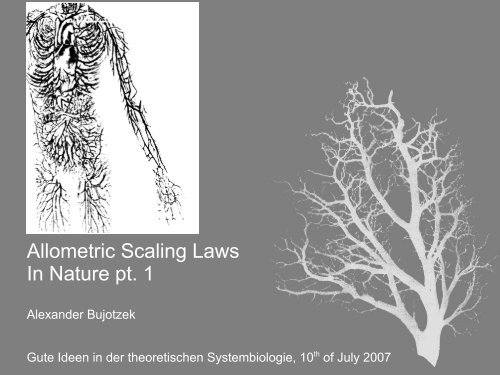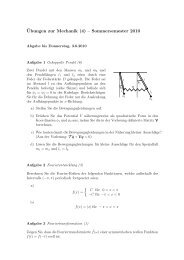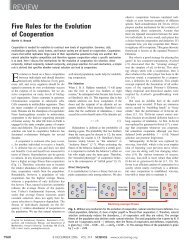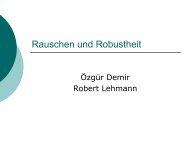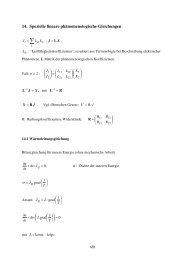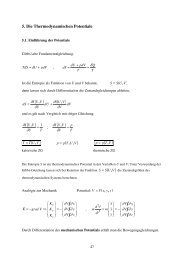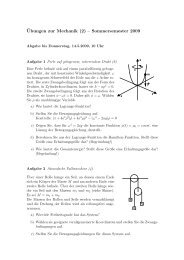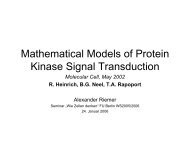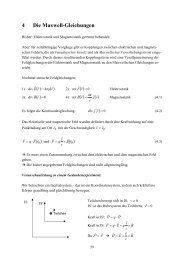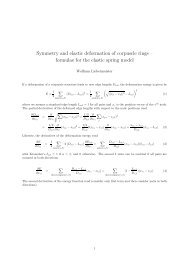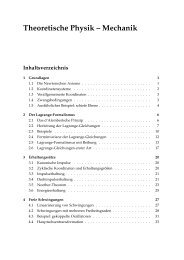Allometric Scaling Laws In Nature pt. 1
Allometric Scaling Laws In Nature pt. 1
Allometric Scaling Laws In Nature pt. 1
You also want an ePaper? Increase the reach of your titles
YUMPU automatically turns print PDFs into web optimized ePapers that Google loves.
<strong>Allometric</strong> <strong>Scaling</strong> <strong>Laws</strong><br />
<strong>In</strong> <strong>Nature</strong> <strong>pt</strong>. 1<br />
Alexander Bujotzek<br />
Gute Ideen in der theoretischen Systembiologie, 10 th of July 2007
<strong>In</strong>troduction<br />
„<strong>In</strong> jeder reinen Naturlehre ist nur<br />
soviel an eigentlicher Wissenschaft<br />
enthalten, als Mathematik in ihr<br />
angewandt werden kann.“<br />
Immanuel Kant (1724 – 1804)<br />
<strong>Allometric</strong> <strong>Scaling</strong> <strong>Laws</strong> <strong>In</strong> <strong>Nature</strong> <strong>pt</strong>. 1 – Alexander Bujotzek<br />
2
<strong>In</strong>troduction<br />
„<strong>In</strong> jeder reinen Naturlehre ist nur<br />
soviel an eigentlicher Wissenschaft<br />
enthalten, als Mathematik in ihr<br />
angewandt werden kann.“<br />
Immanuel Kant (1724 – 1804)<br />
Physics and chemistry (e.g. Newton's laws) have<br />
been elevated to true science...<br />
qualitative quantitative, predictive<br />
But what about biology?<br />
<strong>Allometric</strong> <strong>Scaling</strong> <strong>Laws</strong> <strong>In</strong> <strong>Nature</strong> <strong>pt</strong>. 1 – Alexander Bujotzek<br />
3
<strong>In</strong>troduction<br />
We know about general principles:<br />
●<br />
●<br />
[1] [2]<br />
Mendelian laws of inheritance<br />
Natural selection (Darwin's theory of evolution)<br />
<strong>Allometric</strong> <strong>Scaling</strong> <strong>Laws</strong> <strong>In</strong> <strong>Nature</strong> <strong>pt</strong>. 1 – Alexander Bujotzek<br />
4
<strong>In</strong>troduction<br />
We know about general principles:<br />
●<br />
●<br />
[1] [2]<br />
Mendelian laws of inheritance<br />
Natural selection (Darwin's theory of evolution)<br />
Does life have more, universal and quantifiable laws?<br />
qualitative quantitative, predictive<br />
<strong>Scaling</strong> of biological systems might give us a hint...<br />
<strong>Allometric</strong> <strong>Scaling</strong> <strong>Laws</strong> <strong>In</strong> <strong>Nature</strong> <strong>pt</strong>. 1 – Alexander Bujotzek<br />
5
<strong>Allometric</strong> <strong>Scaling</strong> <strong>Scaling</strong>?<br />
toy ship [3]<br />
<strong>Scaling</strong> laws deal with:<br />
●<br />
●<br />
real ship [4]<br />
measuring and comparing the relation of scale to<br />
the parameters of a system<br />
revealing scale invariant quantities<br />
<strong>Allometric</strong> <strong>Scaling</strong> <strong>Laws</strong> <strong>In</strong> <strong>Nature</strong> <strong>pt</strong>. 1 – Alexander Bujotzek<br />
6
<strong>Allometric</strong> <strong>Scaling</strong> <strong>Scaling</strong>?<br />
<strong>In</strong> physics, scaling laws typically...<br />
●<br />
●<br />
reflect underlying generic features and physical<br />
principles<br />
are independent of detailed dynamics and specific<br />
characteristics<br />
<strong>Allometric</strong> <strong>Scaling</strong> <strong>Laws</strong> <strong>In</strong> <strong>Nature</strong> <strong>pt</strong>. 1 – Alexander Bujotzek<br />
7
<strong>Allometric</strong> <strong>Scaling</strong> <strong>Scaling</strong>?<br />
<strong>In</strong> physics, scaling laws typically...<br />
●<br />
●<br />
reflect underlying generic features and physical<br />
principles<br />
are independent of detailed dynamics and specific<br />
characteristics<br />
Therefore, scaling also has relevance for biology.<br />
This brought up the idea of allometry.<br />
[greek: allos = different; metrie = to measure]<br />
<strong>Allometric</strong> <strong>Scaling</strong> <strong>Laws</strong> <strong>In</strong> <strong>Nature</strong> <strong>pt</strong>. 1 – Alexander Bujotzek<br />
8
Allometry deals with<br />
●<br />
<strong>Allometric</strong> <strong>Scaling</strong> Definition<br />
measuring and comparing the relation of body<br />
size / mass to different biological parameters<br />
Classical allometric equation (Otto Snell, 1892):<br />
Y = Y 0<br />
⋅M b ,<br />
[5]<br />
<strong>Allometric</strong> <strong>Scaling</strong> <strong>Laws</strong> <strong>In</strong> <strong>Nature</strong> <strong>pt</strong>. 1 – Alexander Bujotzek<br />
9
Allometry deals with<br />
●<br />
<strong>Allometric</strong> <strong>Scaling</strong> Definition<br />
measuring and comparing the relation of body<br />
size / mass to different biological parameters<br />
Classical allometric equation (Otto Snell, 1892):<br />
Y = Y 0<br />
⋅M b ,<br />
dependent parameter Y<br />
integration constant Y 0<br />
body mass M<br />
scaling exponent b<br />
b 0 pos. allometry, b 0 neg. allometry, b = 1 isometry<br />
[5]<br />
<strong>Allometric</strong> <strong>Scaling</strong> <strong>Laws</strong> <strong>In</strong> <strong>Nature</strong> <strong>pt</strong>. 1 – Alexander Bujotzek<br />
10
Allometry deals with<br />
●<br />
<strong>Allometric</strong> <strong>Scaling</strong> Definition<br />
measuring and comparing the relation of body<br />
size / mass to different biological parameters<br />
Classical allometric equation (Otto Snell, 1892):<br />
Y = Y 0<br />
⋅M b<br />
log Y = b log M logY 0<br />
[5]<br />
<strong>Allometric</strong> <strong>Scaling</strong> <strong>Laws</strong> <strong>In</strong> <strong>Nature</strong> <strong>pt</strong>. 1 – Alexander Bujotzek<br />
11
<strong>Allometric</strong> <strong>Scaling</strong> Kleiber's Law<br />
The work of Max Kleiber (1932):<br />
metabolic rates (kcal/day) of mammals and birds<br />
LOG METABOLIC RATE (kcal/day)<br />
[6]<br />
LOG MASS (kg)<br />
[West, Brown (2004)]<br />
<strong>Allometric</strong> <strong>Scaling</strong> <strong>Laws</strong> <strong>In</strong> <strong>Nature</strong> <strong>pt</strong>. 1 – Alexander Bujotzek<br />
12
<strong>Allometric</strong> <strong>Scaling</strong> Kleiber's Law<br />
The work of Max Kleiber (1932):<br />
metabolic rates (kcal/day) of mammals and birds<br />
LOG METABOLIC RATE (kcal/day)<br />
best slope fit = ¾<br />
[6]<br />
LOG MASS (kg)<br />
[West, Brown (2004)]<br />
<strong>Allometric</strong> <strong>Scaling</strong> <strong>Laws</strong> <strong>In</strong> <strong>Nature</strong> <strong>pt</strong>. 1 – Alexander Bujotzek<br />
13
<strong>Allometric</strong> <strong>Scaling</strong> Kleiber's Law<br />
Extension of Kleiber's work: metabolic rates of life<br />
covering over 27 orders of magnitude in mass<br />
LOG METABOLIC RATE (kcal/day)<br />
LOG MASS (kg)<br />
[West, Brown (2004)]<br />
<strong>Allometric</strong> <strong>Scaling</strong> <strong>Laws</strong> <strong>In</strong> <strong>Nature</strong> <strong>pt</strong>. 1 – Alexander Bujotzek<br />
14
<strong>Allometric</strong> <strong>Scaling</strong> Kleiber's Law<br />
Extension of Kleiber's work: metabolic rates of life<br />
covering over 27 orders of magnitude in mass<br />
[9]<br />
[7]<br />
[8]<br />
LOG METABOLIC RATE (kcal/day)<br />
[10]<br />
LOG MASS (kg)<br />
[West, Brown (2004)]<br />
<strong>Allometric</strong> <strong>Scaling</strong> <strong>Laws</strong> <strong>In</strong> <strong>Nature</strong> <strong>pt</strong>. 1 – Alexander Bujotzek<br />
15
<strong>Allometric</strong> <strong>Scaling</strong> Kleiber's Law<br />
Extension of Kleiber's work: metabolic rates of life<br />
covering over 27 orders of magnitude in mass<br />
[9]<br />
[7]<br />
[8]<br />
LOG METABOLIC RATE (kcal/day)<br />
[10]<br />
best slope fit = ¾<br />
LOG MASS (kg)<br />
[West, Brown (2004)]<br />
<strong>Allometric</strong> <strong>Scaling</strong> <strong>Laws</strong> <strong>In</strong> <strong>Nature</strong> <strong>pt</strong>. 1 – Alexander Bujotzek<br />
16
<strong>Allometric</strong> <strong>Scaling</strong> Kleiber's Law<br />
This leads to Kleiber's law:<br />
B ∝ M 3 / 4 , metabolic rate B<br />
body mass M<br />
metabolic exponent b ≈ 3/ 4<br />
<strong>Allometric</strong> <strong>Scaling</strong> <strong>Laws</strong> <strong>In</strong> <strong>Nature</strong> <strong>pt</strong>. 1 – Alexander Bujotzek<br />
17
<strong>Allometric</strong> <strong>Scaling</strong> Kleiber's Law<br />
This leads to Kleiber's law:<br />
B ∝ M 3 / 4 , metabolic rate B<br />
body mass M<br />
metabolic exponent b ≈ 3/ 4<br />
<strong>Scaling</strong> with multiples of ¼ seems to be a common<br />
principle in nature...<br />
<strong>Allometric</strong> <strong>Scaling</strong> <strong>Laws</strong> <strong>In</strong> <strong>Nature</strong> <strong>pt</strong>. 1 – Alexander Bujotzek<br />
18
<strong>Allometric</strong> <strong>Scaling</strong> Quarter-Power <strong>Scaling</strong><br />
Examples for quarter-power scaling:<br />
●<br />
●<br />
●<br />
●<br />
heart rate b ≈ - ¼<br />
life span b ≈ ¼<br />
aorta / tree trunk diameters b ≈ ⅜<br />
genome lengths b ≈ ¼<br />
● population density in forests b ≈ -¾<br />
● ...<br />
<strong>Allometric</strong> <strong>Scaling</strong> <strong>Laws</strong> <strong>In</strong> <strong>Nature</strong> <strong>pt</strong>. 1 – Alexander Bujotzek<br />
19
<strong>Allometric</strong> <strong>Scaling</strong> Quarter-Power <strong>Scaling</strong><br />
As a consequence of quarter-power scaling, some<br />
invariant quantities emerge.<br />
size-independent<br />
<strong>In</strong>variant quantities can be regarded as fundamental,<br />
underlying constraints of a system.<br />
<strong>Allometric</strong> <strong>Scaling</strong> <strong>Laws</strong> <strong>In</strong> <strong>Nature</strong> <strong>pt</strong>. 1 – Alexander Bujotzek<br />
20
<strong>Allometric</strong> <strong>Scaling</strong> Quarter-Power <strong>Scaling</strong><br />
life span increases as M ¼ , heart rate decreases as M -¼<br />
●<br />
●<br />
heartbeats / lifetime<br />
≈ 1.5 · 10 9<br />
ATP molecules synthesized / lifetime<br />
≈ 10 16<br />
<strong>Allometric</strong> <strong>Scaling</strong> <strong>Laws</strong> <strong>In</strong> <strong>Nature</strong> <strong>pt</strong>. 1 – Alexander Bujotzek<br />
21
<strong>Allometric</strong> <strong>Scaling</strong> Quarter-Power <strong>Scaling</strong><br />
life span increases as M ¼ , heart rate decreases as M -¼<br />
●<br />
●<br />
heartbeats / lifetime<br />
≈ 1.5 · 10 9<br />
ATP molecules synthesized / lifetime<br />
≈ 10 16<br />
population density in forests decreases as M -¾ ,<br />
individual power use increases as M ¾<br />
●<br />
power used by all individuals in any size class<br />
≈ invariant<br />
<strong>Allometric</strong> <strong>Scaling</strong> <strong>Laws</strong> <strong>In</strong> <strong>Nature</strong> <strong>pt</strong>. 1 – Alexander Bujotzek<br />
22
Modelling Approach<br />
How can the predominance of quarter power scaling<br />
be explained mathematically?<br />
[West, Brown, Enquist 1997]<br />
<strong>Allometric</strong> <strong>Scaling</strong> <strong>Laws</strong> <strong>In</strong> <strong>Nature</strong> <strong>pt</strong>. 1 – Alexander Bujotzek<br />
23
Life:<br />
Modelling Approach<br />
complex, self-sustaining, reproducing structures<br />
need to service high numbers of microscopic units<br />
<strong>Allometric</strong> <strong>Scaling</strong> <strong>Laws</strong> <strong>In</strong> <strong>Nature</strong> <strong>pt</strong>. 1 – Alexander Bujotzek<br />
24
Life:<br />
Modelling Approach<br />
complex, self-sustaining, reproducing structures<br />
need to service high numbers of microscopic units<br />
with<br />
●<br />
●<br />
●<br />
energy<br />
metabolites<br />
information<br />
in a highly efficient way<br />
<strong>Allometric</strong> <strong>Scaling</strong> <strong>Laws</strong> <strong>In</strong> <strong>Nature</strong> <strong>pt</strong>. 1 – Alexander Bujotzek<br />
25
Modelling Approach<br />
Natural selection evolved networks to solve this:<br />
●<br />
●<br />
●<br />
●<br />
animal circulatory systems<br />
plant vascular systems<br />
ecosystems (e.g. forests)<br />
intracellular networks<br />
● ...<br />
<strong>Allometric</strong> <strong>Scaling</strong> <strong>Laws</strong> <strong>In</strong> <strong>Nature</strong> <strong>pt</strong>. 1 – Alexander Bujotzek<br />
26
Modelling Approach<br />
Natural selection evolved networks to solve this:<br />
●<br />
●<br />
●<br />
●<br />
animal circulatory systems<br />
plant vascular systems<br />
ecosystems (e.g. forests)<br />
intracellular networks<br />
● ...<br />
These networks have to fulfill certain properties /<br />
there exist certain constraints...<br />
<strong>Allometric</strong> <strong>Scaling</strong> <strong>Laws</strong> <strong>In</strong> <strong>Nature</strong> <strong>pt</strong>. 1 – Alexander Bujotzek<br />
27
Constraints on biological networks:<br />
Modelling Approach<br />
(1) the organism's whole volume has to be supplied<br />
space filling, fractal-like branching pattern<br />
<strong>Allometric</strong> <strong>Scaling</strong> <strong>Laws</strong> <strong>In</strong> <strong>Nature</strong> <strong>pt</strong>. 1 – Alexander Bujotzek<br />
28
Constraints on biological networks:<br />
Modelling Approach<br />
(1) the organism's whole volume has to be supplied<br />
space filling, fractal-like branching pattern<br />
(2) the network's final branch is a size-invariant unit<br />
cappilaries, leaves, mitochondria, chloroplasts<br />
<strong>Allometric</strong> <strong>Scaling</strong> <strong>Laws</strong> <strong>In</strong> <strong>Nature</strong> <strong>pt</strong>. 1 – Alexander Bujotzek<br />
29
Constraints on biological networks:<br />
Modelling Approach<br />
(1) the organism's whole volume has to be supplied<br />
space filling, fractal-like branching pattern<br />
(2) the network's final branch is a size-invariant unit<br />
cappilaries, leaves, mitochondria, chloroplasts<br />
(3) the energy to distribute resources is minimized<br />
evolution towards o<strong>pt</strong>imal state<br />
<strong>Allometric</strong> <strong>Scaling</strong> <strong>Laws</strong> <strong>In</strong> <strong>Nature</strong> <strong>pt</strong>. 1 – Alexander Bujotzek<br />
30
Short Excourse: Fractals<br />
Fractals (lat. fractus: broken):<br />
●<br />
●<br />
●<br />
evolution of Sierpinski triangle, recursion de<strong>pt</strong>h four [11]<br />
fragmented geometric shapes<br />
each fragment is reduced-size copy of the whole<br />
self-similarity<br />
simple and recursive definition<br />
<strong>Allometric</strong> <strong>Scaling</strong> <strong>Laws</strong> <strong>In</strong> <strong>Nature</strong> <strong>pt</strong>. 1 – Alexander Bujotzek<br />
31
Short Excourse: Fractals<br />
Fractal dimensionality:<br />
●<br />
●<br />
●<br />
evolution of Sierpinski triangle, recursion de<strong>pt</strong>h four [11]<br />
indicates „how completely a fractal will fill space“<br />
Mandelbrot (1975): fractals, usually, have nonwhole<br />
numbered dimensionality<br />
„too big to be thought of as one-dimensional,<br />
but too thin to be two-dimensional“<br />
<strong>Allometric</strong> <strong>Scaling</strong> <strong>Laws</strong> <strong>In</strong> <strong>Nature</strong> <strong>pt</strong>. 1 – Alexander Bujotzek<br />
32
Short Excourse: Fractals<br />
evolution of Sierpinski triangle, recursion de<strong>pt</strong>h four [11]<br />
Example: dimensionality D of Sierpinski triangle<br />
D = lim 0<br />
log N <br />
log 1 = lim k ∞<br />
log 3 k<br />
log 2 k = log 3<br />
log 2 ≈ 1.585<br />
= linear size of self-similar fragments<br />
N = # self-similar fragments to cover whole original object<br />
k = recursion de<strong>pt</strong>h<br />
<strong>Allometric</strong> <strong>Scaling</strong> <strong>Laws</strong> <strong>In</strong> <strong>Nature</strong> <strong>pt</strong>. 1 – Alexander Bujotzek<br />
33
Short Excourse: Fractals<br />
evolution of Sierpinski triangle, recursion de<strong>pt</strong>h four [11]<br />
Example: dimensionality D of Sierpinski triangle<br />
D = lim 0<br />
log N <br />
log 1 = lim k ∞<br />
log 3 k<br />
log 2 k = log 3<br />
log 2 ≈ 1.585<br />
in each step k 3 k new triangles with side length (½) k<br />
= linear size of self-similar fragments<br />
N = # self-similar fragments to cover whole original object<br />
k = recursion de<strong>pt</strong>h<br />
<strong>Allometric</strong> <strong>Scaling</strong> <strong>Laws</strong> <strong>In</strong> <strong>Nature</strong> <strong>pt</strong>. 1 – Alexander Bujotzek<br />
34
Derivation of Quarter-Power <strong>Scaling</strong><br />
Fractal-like structures in nature:<br />
●<br />
self-similarity not perfect, but stochastic<br />
● limited recursion de<strong>pt</strong>h<br />
[12]<br />
<strong>Allometric</strong> <strong>Scaling</strong> <strong>Laws</strong> <strong>In</strong> <strong>Nature</strong> <strong>pt</strong>. 1 – Alexander Bujotzek<br />
35
Derivation of Quarter-Power <strong>Scaling</strong><br />
Fractal-like structures in nature:<br />
●<br />
self-similarity not perfect, but stochastic<br />
● limited recursion de<strong>pt</strong>h<br />
[12]<br />
<strong>Allometric</strong> <strong>Scaling</strong> <strong>Laws</strong> <strong>In</strong> <strong>Nature</strong> <strong>pt</strong>. 1 – Alexander Bujotzek<br />
36
Derivation of Quarter-Power <strong>Scaling</strong><br />
Fractal-like structures in nature:<br />
●<br />
●<br />
self-similarity not perfect, but stochastic<br />
limited recursion de<strong>pt</strong>h<br />
[12]<br />
biological networks (here: circulatory system) are fractal-like<br />
<strong>Allometric</strong> <strong>Scaling</strong> <strong>Laws</strong> <strong>In</strong> <strong>Nature</strong> <strong>pt</strong>. 1 – Alexander Bujotzek<br />
37
Derivation of Quarter-Power <strong>Scaling</strong><br />
(1) space filling, fractal-like branching pattern<br />
(2) final branch is a size-invariant unit<br />
(3) energy to distribute resources is minimized<br />
(use of hydrodynamic laws)<br />
strict mathematical derivation of exponent ¾ possible<br />
<strong>Allometric</strong> <strong>Scaling</strong> <strong>Laws</strong> <strong>In</strong> <strong>Nature</strong> <strong>pt</strong>. 1 – Alexander Bujotzek<br />
38
Derivation of Quarter-Power <strong>Scaling</strong><br />
(1) space filling, fractal-like branching pattern<br />
(2) final branch is a size-invariant unit<br />
(3) energy to distribute resources is minimized<br />
(use of hydrodynamic laws)<br />
strict mathematical derivation of exponent ¾ possible<br />
B ∝ M<br />
3<br />
4<br />
<strong>Allometric</strong> <strong>Scaling</strong> <strong>Laws</strong> <strong>In</strong> <strong>Nature</strong> <strong>pt</strong>. 1 – Alexander Bujotzek<br />
39
Derivation of Quarter-Power <strong>Scaling</strong><br />
(1) space filling, fractal-like branching pattern<br />
(2) final branch is a size-invariant unit<br />
(3) energy to distribute resources is minimized<br />
(use of hydrodynamic laws)<br />
strict mathematical derivation of exponent ¾ possible<br />
B ∝ M<br />
3<br />
4<br />
3 = dimensionality of space<br />
<strong>Allometric</strong> <strong>Scaling</strong> <strong>Laws</strong> <strong>In</strong> <strong>Nature</strong> <strong>pt</strong>. 1 – Alexander Bujotzek<br />
40
Derivation of Quarter-Power <strong>Scaling</strong><br />
(1) space filling, fractal-like branching pattern<br />
(2) final branch is a size-invariant unit<br />
(3) energy to distribute resources is minimized<br />
(use of hydrodynamic laws)<br />
strict mathematical derivation of exponent ¾ possible<br />
B ∝ M<br />
3<br />
4<br />
3 = dimensionality of space<br />
4 = 3 + 1 = increase in dimensionality<br />
due to fractal-like space filling<br />
<strong>Allometric</strong> <strong>Scaling</strong> <strong>Laws</strong> <strong>In</strong> <strong>Nature</strong> <strong>pt</strong>. 1 – Alexander Bujotzek<br />
41
<strong>Allometric</strong> <strong>Scaling</strong> <strong>Laws</strong><br />
<strong>In</strong> <strong>Nature</strong> <strong>pt</strong>. 2<br />
Marcel Grunert<br />
Gute Ideen in der theoretischen Systembiologie, 10 th of July 2007<br />
42
Blood Circulation<br />
Cardiovascular system<br />
➔<br />
aorta, arteries, arterioles and capillaries<br />
Figure: A representation of the<br />
circulatory system of the blood.<br />
(http://www.uh.edu/engines/)<br />
<strong>Allometric</strong> <strong>Scaling</strong> <strong>Laws</strong> <strong>In</strong> <strong>Nature</strong> <strong>pt</strong>. 2 – Marcel Grunert<br />
43
Blood Circulation<br />
➔<br />
N branchings from aorta (level 0) to capillaries (level N)<br />
<strong>Allometric</strong> <strong>Scaling</strong> <strong>Laws</strong> <strong>In</strong> <strong>Nature</strong> <strong>pt</strong>. 2 – Marcel Grunert<br />
44
Conservation of Fluid<br />
Recall: B ∝ M 3/4 (Kleiber's Law)<br />
Since the fluid transports oxygen, nutrients, etc.<br />
for metabolism:<br />
B ∝ Q 0<br />
(metabolic rate ∝ volume flow rate)<br />
⇒ if B ∝ M a<br />
then Q 0 ∝ M a<br />
(a will be determined later)<br />
Conservation of fluid:<br />
Q 0 = N c Q c = N c πr 2 cu c<br />
<strong>Allometric</strong> <strong>Scaling</strong> <strong>Laws</strong> <strong>In</strong> <strong>Nature</strong> <strong>pt</strong>. 2 – Marcel Grunert<br />
45
Conservation of Fluid<br />
Conservation of fluid:<br />
Q 0 = N c Q c = N c πr 2 cu c<br />
Volume<br />
flow rate<br />
<strong>Allometric</strong> <strong>Scaling</strong> <strong>Laws</strong> <strong>In</strong> <strong>Nature</strong> <strong>pt</strong>. 2 – Marcel Grunert<br />
46
Conservation of Fluid<br />
Conservation of fluid:<br />
Q 0 = N c Q c = N c πr 2 cu c<br />
Volume<br />
flow rate<br />
Total number<br />
of capillaries<br />
<strong>Allometric</strong> <strong>Scaling</strong> <strong>Laws</strong> <strong>In</strong> <strong>Nature</strong> <strong>pt</strong>. 2 – Marcel Grunert<br />
47
Conservation of Fluid<br />
Conservation of fluid:<br />
Q 0 = N c Q c = N c πr 2 cu c<br />
Volume<br />
flow rate<br />
Total number<br />
of capillaries<br />
Volume flow rate<br />
in average capillary<br />
<strong>Allometric</strong> <strong>Scaling</strong> <strong>Laws</strong> <strong>In</strong> <strong>Nature</strong> <strong>pt</strong>. 2 – Marcel Grunert<br />
48
Conservation of Fluid<br />
Conservation of fluid:<br />
Q 0 = N c Q c = N c πr 2 cu c<br />
Volume<br />
flow rate<br />
Total number<br />
of capillaries<br />
Volume flow rate<br />
in average capillary<br />
→ Capillary is an invariant unit<br />
(Recall: scale invariance)<br />
<strong>Allometric</strong> <strong>Scaling</strong> <strong>Laws</strong> <strong>In</strong> <strong>Nature</strong> <strong>pt</strong>. 2 – Marcel Grunert<br />
49
Conservation of Fluid<br />
Capillary is an invariant unit<br />
(Q c is equal for all mammals)<br />
⇒ number of capillaries (N c ) must scale in same way as<br />
the metabolic rate (B ∝ Q 0 ):<br />
B ∝ M 3/4 then N c ∝ M 3/4 (if a=3/4 → to be shown)<br />
N c ∝ M 3/4 but: total number of cells: N cell ∝ M(linear)<br />
⇒ number of cells fed by a single capillary increases<br />
as M 1/4 (efficiency increases with size)<br />
<strong>Allometric</strong> <strong>Scaling</strong> <strong>Laws</strong> <strong>In</strong> <strong>Nature</strong> <strong>pt</strong>. 2 – Marcel Grunert<br />
50
Characterize the Branching<br />
How do radii and length of tubes scale through the network?<br />
- scale factors: β k =r k+1 /r k ,<br />
γ k =l k+1 /l k<br />
Recall: terminal branches of the network are invariant units<br />
⇒ network must be a conventional self-similar fractal<br />
(β k =β, γ k = γ & n k = n)<br />
⇒ number of branches increase in geometric proportion<br />
(N k<br />
=n k ) as their size geometrically decreases from<br />
level 0 to N<br />
<strong>Allometric</strong> <strong>Scaling</strong> <strong>Laws</strong> <strong>In</strong> <strong>Nature</strong> <strong>pt</strong>. 2 – Marcel Grunert<br />
51
Characterize the Branching<br />
N c<br />
=n N ⇒ number of generations of branches scales<br />
only logarithmically with size:<br />
N = a⋅ln M /M 0<br />
lnn<br />
⇒ a whale is 10 7 times heavier than a mouse but<br />
has only about 70% more branchings from aorta<br />
to capillary<br />
Figure: http://www.the-scientist.com<br />
<strong>Allometric</strong> <strong>Scaling</strong> <strong>Laws</strong> <strong>In</strong> <strong>Nature</strong> <strong>pt</strong>. 2 – Marcel Grunert<br />
52
Characterize the Branching<br />
Total volume of fluid in the network (“blood”<br />
volume V b ):<br />
r 2 k<br />
l k<br />
n k ∝ (γβ 2 ) -N V c<br />
N<br />
V =∑ b<br />
k =0<br />
N<br />
N k<br />
V =∑ k<br />
k=0<br />
<strong>Allometric</strong> <strong>Scaling</strong> <strong>Laws</strong> <strong>In</strong> <strong>Nature</strong> <strong>pt</strong>. 2 – Marcel Grunert<br />
53
Characterize the Branching<br />
Total volume of fluid in the network (“blood”<br />
volume V b ):<br />
r 2 k<br />
l k<br />
n k ∝ (γβ 2 ) -N V c<br />
N<br />
V =∑ b<br />
k =0<br />
N<br />
N k<br />
V =∑ k<br />
k=0<br />
Total number of<br />
branches at level k<br />
<strong>Allometric</strong> <strong>Scaling</strong> <strong>Laws</strong> <strong>In</strong> <strong>Nature</strong> <strong>pt</strong>. 2 – Marcel Grunert<br />
54
Characterize the Branching<br />
Total volume of fluid in the network (“blood”<br />
volume V b ):<br />
r 2 k<br />
l k<br />
n k ∝ (γβ 2 ) -N V c<br />
N<br />
V =∑ b<br />
k =0<br />
N<br />
N k<br />
V =∑ k<br />
k=0<br />
Total number of<br />
branches at level k<br />
Volume<br />
of tube<br />
<strong>Allometric</strong> <strong>Scaling</strong> <strong>Laws</strong> <strong>In</strong> <strong>Nature</strong> <strong>pt</strong>. 2 – Marcel Grunert<br />
55
Characterize the Branching<br />
Total volume of fluid in the network (“blood”<br />
volume V b ):<br />
r 2 k<br />
l k<br />
n k ∝ (γβ 2 ) -N V c<br />
N<br />
V =∑ b<br />
k =0<br />
N<br />
N k<br />
V =∑ k<br />
k=0<br />
Total number of<br />
branches at level k<br />
Volume<br />
of tube<br />
Reflects the fractal<br />
nature of the system<br />
<strong>Allometric</strong> <strong>Scaling</strong> <strong>Laws</strong> <strong>In</strong> <strong>Nature</strong> <strong>pt</strong>. 2 – Marcel Grunert<br />
56
Characterize the Branching<br />
Total volume of fluid in the network (“blood”<br />
volume V b ):<br />
r 2 k<br />
l k<br />
n k ∝ (γβ 2 ) -N V c<br />
N<br />
V =∑ b<br />
k =0<br />
N<br />
N k<br />
V =∑ k<br />
k=0<br />
Total number of<br />
branches at level k<br />
Volume<br />
of tube<br />
Reflects the fractal<br />
nature of the system<br />
Volume of<br />
capillary<br />
<strong>Allometric</strong> <strong>Scaling</strong> <strong>Laws</strong> <strong>In</strong> <strong>Nature</strong> <strong>pt</strong>. 2 – Marcel Grunert<br />
57
Characterize the Branching<br />
Total volume of fluid in the network (“blood”<br />
volume V b ):<br />
r 2 k<br />
l k<br />
n k ∝ (γβ 2 ) -N V c<br />
N<br />
V =∑ b<br />
k =0<br />
N<br />
N k<br />
V =∑ k<br />
k=0<br />
Total number of<br />
branches at level k<br />
Volume<br />
of tube<br />
Reflects the fractal<br />
nature of the system<br />
Volume of<br />
capillary<br />
Remember:<br />
N = a⋅ln M / M 0 <br />
lnn<br />
&<br />
V b<br />
∝ (γβ 2 ) -N V c<br />
a = - ln(n)/ln(γβ 2 )<br />
<strong>Allometric</strong> <strong>Scaling</strong> <strong>Laws</strong> <strong>In</strong> <strong>Nature</strong> <strong>pt</strong>. 2 – Marcel Grunert<br />
58
Derivation of ¾ Exponent<br />
Further knowledge about β and γ:<br />
N k l d k ≈ N k+1 l d k+1 (“volume preserving”)<br />
d-dimensional volume of space<br />
filled by branch of size l k<br />
Number of branches of size l k<br />
⇒ k = l k 1<br />
l k<br />
=<br />
1/ d<br />
N k<br />
= 1<br />
N k1 n 1/ d<br />
branches ratio<br />
<strong>Allometric</strong> <strong>Scaling</strong> <strong>Laws</strong> <strong>In</strong> <strong>Nature</strong> <strong>pt</strong>. 2 – Marcel Grunert<br />
59
Derivation of ¾ Exponent<br />
The sum of the cross-sectional areas of the daughter<br />
branches equals that of the parent:<br />
πr 2 k = nπr2 k+1<br />
x-sectional area<br />
of parent branch<br />
x-sectional area of<br />
each daughter<br />
Number of daughters<br />
(branching ratio)<br />
⇒ k<br />
= r k1<br />
r k<br />
= 1<br />
n 1 /2<br />
<strong>Allometric</strong> <strong>Scaling</strong> <strong>Laws</strong> <strong>In</strong> <strong>Nature</strong> <strong>pt</strong>. 2 – Marcel Grunert<br />
60
Derivation of ¾ Exponent<br />
Recall: if B∝M a ⇒ N c<br />
=n N ∝M a<br />
if V b<br />
∝M and V c<br />
∝M<br />
0<br />
⇒ a = - ln n / ln (γβ 2 )<br />
with γ = n -1/3<br />
β = n -1/2<br />
(space-filling)<br />
(area-preserving)<br />
⇒ a = ¾ (independent of n)<br />
<strong>Allometric</strong> <strong>Scaling</strong> <strong>Laws</strong> <strong>In</strong> <strong>Nature</strong> <strong>pt</strong>. 2 – Marcel Grunert<br />
61
Derivation of ¾ Exponent<br />
<strong>In</strong> d-Dimensions:<br />
B ∝ M d/(d+1)<br />
⇒ we live in 3 spatial dimensions, so B ∝ M 3/4<br />
●<br />
●<br />
“3” represents dimensionality of space<br />
“4” increase in dimensionality due to<br />
fractal-like space filling<br />
<strong>Allometric</strong> <strong>Scaling</strong> <strong>Laws</strong> <strong>In</strong> <strong>Nature</strong> <strong>pt</strong>. 2 – Marcel Grunert<br />
62
Further <strong>Scaling</strong> <strong>Laws</strong><br />
Radius and length of aorta:<br />
●<br />
Radius:<br />
r 0<br />
= −N r c<br />
= N c<br />
1 / 2 r c<br />
⇒r 0 ∝ M 3/8<br />
●<br />
Length:<br />
l o<br />
= −N r c<br />
=N c<br />
1/ 3 l c<br />
⇒l 0 ∝ M 1/4<br />
Hydrodynamic resistance of the network:<br />
∼ 1/M 3/4<br />
⇒ Total resistance decrease with size<br />
(small may be beautiful but large is more efficient)<br />
<strong>Allometric</strong> <strong>Scaling</strong> <strong>Laws</strong> <strong>In</strong> <strong>Nature</strong> <strong>pt</strong>. 2 – Marcel Grunert<br />
63
Further <strong>Scaling</strong> <strong>Laws</strong><br />
Respiratory system<br />
●<br />
Tracheal radius ∼ M 3/8<br />
●<br />
Oxygen consum<strong>pt</strong>ion rate ∼ M 3/4<br />
●<br />
Total resistance ∼ 1/M 3/4<br />
●<br />
Volume flow to lung ∼ M 3/4<br />
Figure: 3D-Lung<br />
(http://www.newportbodyscan.com)<br />
<strong>Allometric</strong> <strong>Scaling</strong> <strong>Laws</strong> <strong>In</strong> <strong>Nature</strong> <strong>pt</strong>. 2 – Marcel Grunert<br />
64
Further <strong>Scaling</strong> <strong>Laws</strong><br />
Overview of further scaling laws<br />
<strong>Allometric</strong> <strong>Scaling</strong> <strong>Laws</strong> <strong>In</strong> <strong>Nature</strong> <strong>pt</strong>. 2 – Marcel Grunert<br />
65
Further <strong>Scaling</strong> <strong>Laws</strong><br />
Model (Y=Y 0 M b ) predicts the known scaling relations<br />
of mammalian systems:<br />
<strong>Allometric</strong> <strong>Scaling</strong> <strong>Laws</strong> <strong>In</strong> <strong>Nature</strong> <strong>pt</strong>. 2 – Marcel Grunert<br />
66
<strong>Allometric</strong> <strong>Scaling</strong> <strong>Laws</strong><br />
<strong>In</strong> <strong>Nature</strong> <strong>pt</strong>. 3<br />
Katharina Albers<br />
Gute Ideen in der theoretischen Systembiologie, 10 th of July 2007<br />
67
Motivation<br />
Trees are the biggest<br />
and most durable<br />
organisms!<br />
Why do they grow<br />
as they do?<br />
www.baumwunder.de<br />
<strong>Allometric</strong> <strong>Scaling</strong> <strong>Laws</strong> <strong>In</strong> <strong>Nature</strong> <strong>pt</strong>. 3 – Katharina Albers<br />
68
Motivation<br />
Wunder der Welt: Bäume<br />
<strong>Allometric</strong> <strong>Scaling</strong> <strong>Laws</strong> <strong>In</strong> <strong>Nature</strong> <strong>pt</strong>. 3 – Katharina Albers<br />
69
<strong>Scaling</strong> laws for trees<br />
Diameter of aortas<br />
Diameter of tree trunks<br />
in both cases: b ≈ ⅜<br />
West et al: A General Model for ... (1997)<br />
<strong>Allometric</strong> <strong>Scaling</strong> <strong>Laws</strong> <strong>In</strong> <strong>Nature</strong> <strong>pt</strong>. 3 – Katharina Albers<br />
70
<strong>Scaling</strong> laws for trees<br />
● Diameter of trunk in<br />
proportion to the<br />
height bigger in larger<br />
trees<br />
●<br />
Can be explained<br />
with help of<br />
dimensional analysis<br />
McMahon et al: Form und Leben (1985)<br />
<strong>Allometric</strong> <strong>Scaling</strong> <strong>Laws</strong> <strong>In</strong> <strong>Nature</strong> <strong>pt</strong>. 3 – Katharina Albers<br />
71
Dimensional Analysis<br />
●<br />
Conce<strong>pt</strong>ual tool applied in physics, chemics and<br />
engineering<br />
●<br />
To understand physical situations involving a mix of<br />
different kinds of physical quantities<br />
●<br />
Used to form reasonable hypotheses about complex<br />
physical situations<br />
●<br />
Example: Mach-number. Air stream around plane<br />
changes dramatically when it's faster than Sound.<br />
Dimensionless relation flight velocity/acoustic velocity<br />
given by Mach-number.<br />
<strong>Allometric</strong> <strong>Scaling</strong> <strong>Laws</strong> <strong>In</strong> <strong>Nature</strong> <strong>pt</strong>. 3 – Katharina Albers<br />
72
<strong>Scaling</strong> laws for trees<br />
●<br />
Important variables:<br />
Diameter<br />
Height<br />
Elastic modulus<br />
Relative density<br />
●<br />
Dimensional analysis yields:<br />
Elastic modulus⋅ Diameter 2<br />
Gravity⋅Relative density⋅ Height 3<br />
<strong>Allometric</strong> <strong>Scaling</strong> <strong>Laws</strong> <strong>In</strong> <strong>Nature</strong> <strong>pt</strong>. 3 – Katharina Albers<br />
73
<strong>Scaling</strong> laws for trees<br />
●<br />
Relation of elastic modulus and specific gravity<br />
alike for living wood<br />
Diameter 2<br />
Height 3<br />
nearly constant<br />
Height ∝ Diameter 2 / 3<br />
<strong>Allometric</strong> <strong>Scaling</strong> <strong>Laws</strong> <strong>In</strong> <strong>Nature</strong> <strong>pt</strong>. 3 – Katharina Albers<br />
74
<strong>Scaling</strong> laws for trees<br />
Same conclusion by Greenhill in 1881, but with<br />
different arguments:<br />
How high can a (cylindric) flag pole become<br />
without collapsing?<br />
<strong>Laws</strong> of solid mechanics:<br />
A pole with diameter 53 cm can be 91 m high at<br />
most.<br />
Complies with conclusion of dimensional<br />
analysis!!<br />
<strong>Allometric</strong> <strong>Scaling</strong> <strong>Laws</strong> <strong>In</strong> <strong>Nature</strong> <strong>pt</strong>. 3 – Katharina Albers<br />
75
<strong>Scaling</strong> laws for trees<br />
McMahon et al: Form und Leben (1985)<br />
<strong>Allometric</strong> <strong>Scaling</strong> <strong>Laws</strong> <strong>In</strong> <strong>Nature</strong> <strong>pt</strong>. 3 – Katharina Albers<br />
76
Self-o<strong>pt</strong>imizing Trees<br />
●<br />
Trees react on outer stimuli like gravity or wind by<br />
thickening according to the stress<br />
●<br />
Controlled by growth hormone auxin, which supports<br />
growth of cambium<br />
●<br />
If trees in the greenhouse are bend regularly, the<br />
trunk grows bigger, and trees outside shouldn't be<br />
supported for too long, because they cannot stand<br />
alone afterwards<br />
<strong>Allometric</strong> <strong>Scaling</strong> <strong>Laws</strong> <strong>In</strong> <strong>Nature</strong> <strong>pt</strong>. 3 – Katharina Albers<br />
77
Self-o<strong>pt</strong>imizing Trees<br />
stems represent a<br />
mechanical o<strong>pt</strong>imum<br />
with respect to tapering,<br />
branch and root<br />
junctions, and inner<br />
architecture<br />
www.umdiewelt.de<br />
<strong>Allometric</strong> <strong>Scaling</strong> <strong>Laws</strong> <strong>In</strong> <strong>Nature</strong> <strong>pt</strong>. 3 – Katharina Albers<br />
78
Self-o<strong>pt</strong>imizing Trees<br />
Trees are perfect selfadjusting<br />
o<strong>pt</strong>imizers:<br />
●<br />
grow according to<br />
forces<br />
●<br />
aim at an even<br />
distribution of the<br />
mechanical stresses<br />
Diameter of trunk<br />
increases downwards Mattheck: Warum alles kaputt<br />
geht (2003)<br />
<strong>Allometric</strong> <strong>Scaling</strong> <strong>Laws</strong> <strong>In</strong> <strong>Nature</strong> <strong>pt</strong>. 3 – Katharina Albers<br />
79
Self-o<strong>pt</strong>imizing Trees<br />
●<br />
<strong>In</strong> transition of trunk and<br />
radix tractive efforts and<br />
compressive forces<br />
cross<br />
Mattheck: Warum alles kaputt geht (2003)<br />
<strong>Allometric</strong> <strong>Scaling</strong> <strong>Laws</strong> <strong>In</strong> <strong>Nature</strong> <strong>pt</strong>. 3 – Katharina Albers<br />
80
Self-o<strong>pt</strong>imizing Trees<br />
●<br />
Woodfibres run<br />
unfavourably<br />
Mattheck: Warum alles kaputt geht (2003)<br />
<strong>Allometric</strong> <strong>Scaling</strong> <strong>Laws</strong> <strong>In</strong> <strong>Nature</strong> <strong>pt</strong>. 3 – Katharina Albers<br />
81
Self-o<strong>pt</strong>imizing Trees<br />
Mattheck: Warum alles kaputt geht (2003)<br />
●<br />
<strong>In</strong> bifurcations the same forces take effect<br />
<strong>Allometric</strong> <strong>Scaling</strong> <strong>Laws</strong> <strong>In</strong> <strong>Nature</strong> <strong>pt</strong>. 3 – Katharina Albers<br />
82
Self-o<strong>pt</strong>imizing Trees<br />
Mattheck: Warum alles kaputt geht (2003)<br />
●<br />
<strong>In</strong>creasing trunk-diameter only in vital trees with low<br />
top<br />
<strong>Allometric</strong> <strong>Scaling</strong> <strong>Laws</strong> <strong>In</strong> <strong>Nature</strong> <strong>pt</strong>. 3 – Katharina Albers<br />
83
Self-o<strong>pt</strong>imizing Trees<br />
Mattheck: Warum alles kaputt geht (2003)<br />
●<br />
Rule of thump: with relation H/D > 50, tree likely to<br />
collaps<br />
<strong>Allometric</strong> <strong>Scaling</strong> <strong>Laws</strong> <strong>In</strong> <strong>Nature</strong> <strong>pt</strong>. 3 – Katharina Albers<br />
84
Self-o<strong>pt</strong>imizing Trees<br />
●<br />
Radix forms an eight, alike the I-beam<br />
Mattheck: Warum alles kaputt geht (2003)<br />
<strong>Allometric</strong> <strong>Scaling</strong> <strong>Laws</strong> <strong>In</strong> <strong>Nature</strong> <strong>pt</strong>. 3 – Katharina Albers<br />
85
Self-o<strong>pt</strong>imizing Trees<br />
Mattheck: Warum alles kaputt geht (2003) www.baumwunder.de<br />
<strong>Allometric</strong> <strong>Scaling</strong> <strong>Laws</strong> <strong>In</strong> <strong>Nature</strong> <strong>pt</strong>. 3 – Katharina Albers<br />
86
Self-o<strong>pt</strong>imizing Trees<br />
Mattheck: Warum alles kaputt geht (2003)<br />
<strong>Allometric</strong> <strong>Scaling</strong> <strong>Laws</strong> <strong>In</strong> <strong>Nature</strong> <strong>pt</strong>. 3 – Katharina Albers<br />
87
Self-o<strong>pt</strong>imizing Trees<br />
Wunder der Welt: Bäume<br />
<strong>Allometric</strong> <strong>Scaling</strong> <strong>Laws</strong> <strong>In</strong> <strong>Nature</strong> <strong>pt</strong>. 3 – Katharina Albers<br />
88
Self-o<strong>pt</strong>imizing Trees<br />
<strong>In</strong> tropical rain forest<br />
trees have huge<br />
wide-spread roots,<br />
because they grow<br />
very high<br />
Wunder der Welt: Bäume<br />
<strong>Allometric</strong> <strong>Scaling</strong> <strong>Laws</strong> <strong>In</strong> <strong>Nature</strong> <strong>pt</strong>. 3 – Katharina Albers<br />
89
References<br />
•<br />
“A General Model for the Origin of <strong>Allometric</strong> <strong>Scaling</strong> <strong>Laws</strong> in Biology“, Geoffrey B. West,<br />
James H. Brown, Brain J. Enquist, Science, Vol. 276, 1997<br />
•<br />
“<strong>Scaling</strong> <strong>Laws</strong> in Biology: Growth, Mortality, Cancer and Sleep”, Geoffrey B. West,<br />
http://online.itp.ucsb.edu/online/pattern_i03/west/<br />
•<br />
“Metabolic Rate and Kleiber's Law”<br />
http://universe-review.ca/R10-35-metabolic.htm<br />
•<br />
http://http://de.wikipedia.org/<br />
Fraktal, Fraktale Dimension, Allometrie, Sierpinski-Dreieck, Immanuel Kant, Kleibers<br />
Gesetz<br />
•<br />
http://en.wikipedia.org/<br />
Fractal, Fractal dimension, Allometry, Power law, Sierpinski triangle, Kleiber's law<br />
•<br />
Mattheck, C. (2003): Warum alles kaputt geht. Karlsruhe<br />
•<br />
Mattheck, C. (2006): Verborgene Gestaltgesetze der Natur. Karlsruhe<br />
•<br />
McMahon, T. & Bonner, J.T. (1985): Form und Leben. Heidelberg<br />
•<br />
Prothero, J. (1999): <strong>Scaling</strong> of tree height and trunk diameter as a function of ring number.<br />
Trees – Structure and Function, Volume 14, Heidelberg, pp 43-48<br />
•<br />
Linford, J.: Wunder der Welt, Bäume. Bath<br />
<strong>Allometric</strong> <strong>Scaling</strong> <strong>Laws</strong> <strong>In</strong> <strong>Nature</strong><br />
90
References<br />
•<br />
www.sciencemag.org/feature/data/deutschman/param_tab.htm<br />
•<br />
www.baumrausch.de<br />
<strong>Allometric</strong> <strong>Scaling</strong> <strong>Laws</strong> <strong>In</strong> <strong>Nature</strong><br />
91
(1) http://upload.wikimedia.org/wikipedia/de/3/3e/Charles_Darwin_1854.jpg<br />
(2) http://upload.wikimedia.org/wikipedia/commons/d/d3/Gregor_Mendel.png<br />
Pictures<br />
(3) http://www.smchamburg.de/bilder/veranstaltungen/anschippern2007/image/anschippern_2007_054.jpg<br />
(4) http://www.corsier-sur-vevey.ch/images/alinghi-sui64.jpg<br />
(5) http://www.nlkh-lueneburg.niedersachsen.de/notiz3.gif<br />
(6) http://animalscience.ucdavis.edu/memorial/MaxKleiber.gif<br />
(7) http://upload.wikimedia.org/wikipedia/en/6/68/Mitochondrion_186.jpg<br />
(8) http://upload.wikimedia.org/wikipedia/commons/7/7c/Epithelial-cells.jpg<br />
(9) http://upload.wikimedia.org/wikipedia/en/thumb/d/d4/Southern_shorttailed_shrew.jpg/250px-Southern_short-tailed_shrew.jpg<br />
(10) http://upload.wikimedia.org/wikipedia/commons/thumb/d/dc/Elephant_near_ndutu.jpg/25<br />
0px-Elephant_near_ndutu.jpg<br />
(11) http://upload.wikimedia.org/wikipedia/commons/thumb/0/05/Sierpinski_triangle_evolutio<br />
n.svg/512px-Sierpinski_triangle_evolution.svg.png<br />
(12) http://upload.wikimedia.org/wikipedia/commons/thumb/e/ea/Romanesco.jpg/214px-<br />
Romanesco.jpg<br />
<strong>Allometric</strong> <strong>Scaling</strong> <strong>Laws</strong> <strong>In</strong> <strong>Nature</strong><br />
92
Thanks for your attention!<br />
http://blog.thiesen.org<br />
<strong>Allometric</strong> <strong>Scaling</strong> <strong>Laws</strong> <strong>In</strong> <strong>Nature</strong><br />
93


